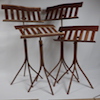Hi All,
I'm building a dining table.
48" wide
Quartersawn Oak (top is just under 1" thick)
Dry I think
Now in garage, temp 66, humidity 30
We're in Wisconsin, kitchen summer probably around 75 degrees and 55 humidity?
Yesterday I attached one of the breadboard ends and forgot to elongate the dowel holes through the tenons. (I used 3/8" oak dowel pins, 5 of them). Also, my breadboard is non-standard. It is really a skirt and breadboard in one (so it is 1.25" horizontal x 5.25" high (thick if you will)). I can try to send/post pictures if needed -- this is my first post so please forgive any errors/omissions/style faux pas I might be making.
It would be a lot of work to cut the breadboard end off and re-do, and, I'm already a couple inches shorter than wife wants table in the first place.
Am I crazy to leave it as is and "give it a try"?
Thanks so much, in advance, for any advice!
Joe




 Reply With Quote
Reply With Quote





